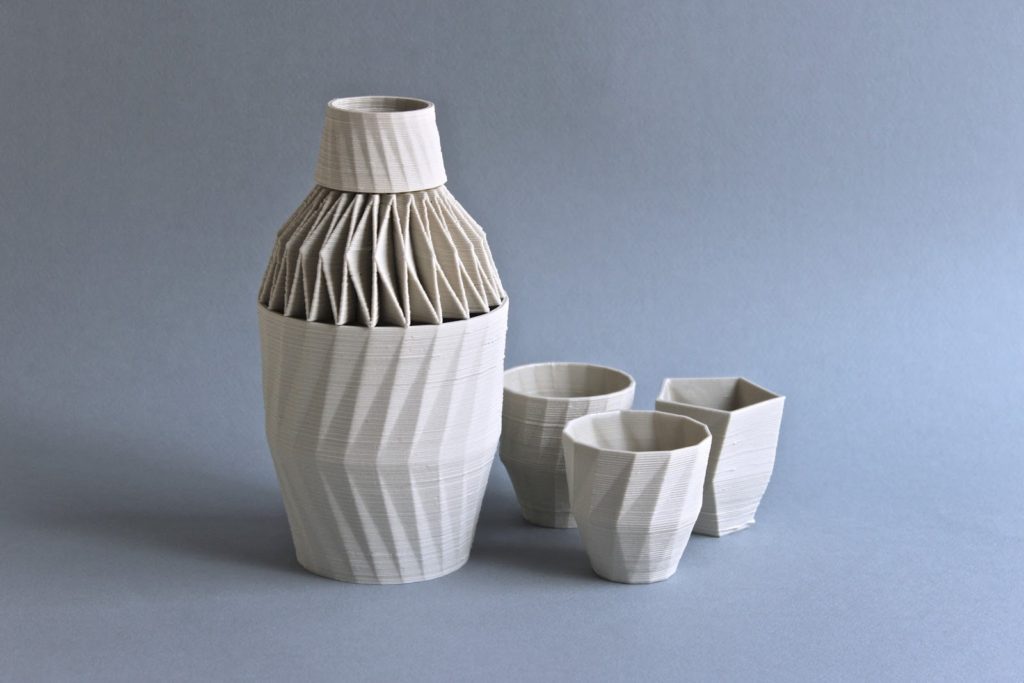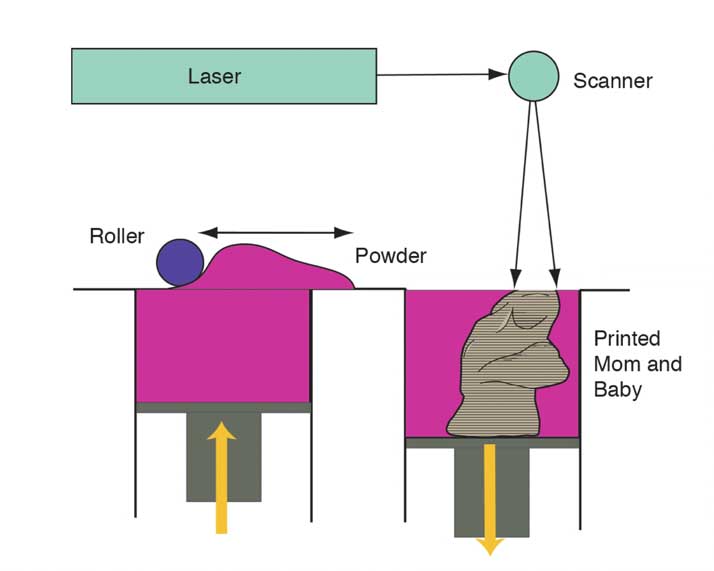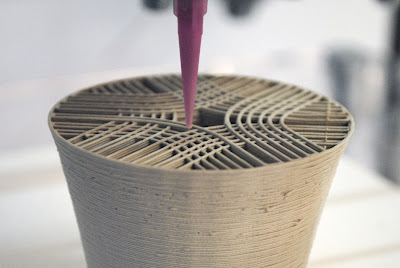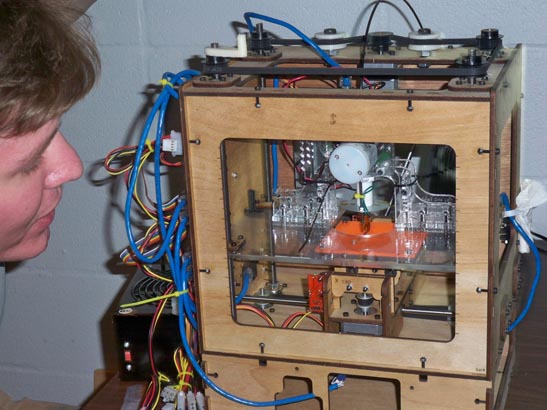Ceramic printing
Must See-3D Printing of Ceramic And DIY

As you may know, if you are a regular reader of my blog, I am both a traditional and a digital sculptor. I entered into digital technologies a few years back and studied bridging the gap between the traditional and digital studio as my MFA. I wrote “Digital Sculpting With Mudbox: Essential Tools and techniques for artists” with Miguel de la Flor a few years back. We did this, not just to feature Mudbox, but there is a chapter that focuses on scanning, printing and milling. I believe this is one of the first printed books for artists that tell you exactly how to do these things. I am working on another book that will feature these processes, a how to. It will also contain artists and their work and process along with being a reference book of vendors.
I have been interested in 3D Printing and have especially been interested in 3D Printing in ceramics. There are many posts on this blog about Solehim at the University of Washington and what they are doing with 3D Printing of ceramics. However, they are using the SLS process and very expensive equipment. This is something that I could not replicate in my own studio.

With the support and excitement about DIY 3D printers I have really been interested in the works of Adrian Bowyer and Rep Rap. In fact I am determined to make my own RepRap or MakerBot within the next year or two. I have been holding off because there seemed to be a connection between Solheim and my own DIY 3D printer that was missing. I need my DIY 3D printer to print ceramic. That means not using a filament that is often used in FDM but instead an extruder.
Enter Unfold~fab A Belgian Design Studio that is doing just that. Yes, can you believe it? And don’t you love it when someone learns something and shares their experience? That is what they are doing on their blog. They are documenting their experiments with using an extruder, the mix, etc for everyone to try. Go Unfold~fab ! This is a blog that everyone interested in 3D printing in ceramic should be watching. I have many questions for Unfold~fab and have requested a podcast interview to add to my Art and Technology podcasts. Maybe I should hook up with the guys at TXRX, a Houston project-based team of makers that like to bring creative people together. I mentioned my interest in printing ceramic on a recent trip to the TXRX. Rex Baker, at the lab was definitely interested. Together maybe we could replicate what Unfold~fab is doing. I need help. I’m geek, but not quite geek enough to figure all of this out.

In the meantime. I’m going to be adding this as part of my lecture “Bridging the Gap Between the Traditional and Digital Sculpture Studio” at 3DCAMP Houston 2012. Also, if your coming to 3DCAMP 2012, please be sure to sign up for my other lecture. “3d Art – Fabric to Frankenstein.” I encourage everyone to attend.
Anyone in Houston interested in helping out with trying to replicate Unfold~fab in my Houston studio?
Bridgette Mongeon is a sculptor, writer, illustrator and educator as well as a public speaker.
Her blog can be found at https://creativesculpture.com.
She is also the owner and creator of the God’s Word Collectible Sculpture series
Follow the artists on twitter twitter.com/Sculptorwriter twitter.com/creategodsword
Facebook http://www.facebook.com/bridgette.mongeon
Listen to The Creative Christian Podcast or the Inspiration/Generation PodcastClick on Podcast Host Bios for a list of all podcasts.
Listen to the Art and Technology Podcast
Which Medium Do You Think Is More Flexible, Digital or Analog Clay? An Austrian Student Interview Cont.
2. Which medium do you think is more flexible, digital or analog clay?
I have described a bit of this in a previous post, however, in defense of digital sculpting, the tools that are available intrigues me. For example, sculpting symmetrically, though no person is symmetrical, I can change that at the end. But in digital I don’t have to sculpt two eyes, or two ears, etc. When I can shorten the amount of time of getting the shape and instead focus on the detail the technical process allows me more time for creativity.
By far the most hindering part of the digital process is the output. There are still a few factors that interfere with my process in this area. One is cost, and the other is the medium, also the build envelope or size. I’m finishing a bust in traditional clay right now, but I would much rather have created it digitally. However, my resources for out put would have been milling in foam, a good armature for larger pieces, but I would have still had to do the details again, and I do not like the stiff look that a piece of foam covered in clay has.

I could mill it out in stone; I must say I anxious to have a project where I can explore this more. All my life I have sculpted in clay, concrete, bronze or pourable mediums. Now with digital milling in stone I can extend my tool set to “stone carver”. With the Digital Stone project, I can create artwork in this medium, as well. This excites me to no end. When I think of the possibilities I also consider the many projects I have given up over the years not having this skill set.
I also love the idea of doing more architectural sculpting work using the digital tools. Creating a finial and being to enlarge it 20% or anything in steps of enlargement is huge. There is no price that can be put on that.
However, digital printing in any other medium is not a viable option, either because of the build envelope or the cost.

Im intrigued with the research at Solheim Additive Manufacturing Laboratory in the Mechanical Engineering Department on the University of Washington campus. If only I could create in the computer and then digitally print out my form in clay in my own studio, like they are doing at this lab. I think this would be a viable resource for me. I know that the open source “free” 3d printers like Rep Rap or maker bot have some attachments to digitally print in clay, and I’m waiting to see how these evolve.
I think another resources is materialize by .mGX for going directly to bronze, though very expensive. I have visions of using them on an intricate piece similar to Alfred Gilbert’s Virgin Mary or St. Michael. Pieces that would be a nightmare to recreate in a triditional bronze process but could easily be done with .MGX.
The very near future will drastically change the way I work. As many of the patents have ended on 3D printing, I believe you will begin to see a change in the cost factor and availability of home 3D printers. I still may be limited by the build size, unless, of course, I can figure out how to change a machine to accommodate my needs. I’m not sure I am that mechanically savvy.
As I write this, I find an aching. To go from screen to finished project without touching it leaves a hole inside of me. I am afraid I will not be able to “feel” the emotion of the piece unless I touch it. Oh, this is a strange thought.
Though looking at the quick sketches in my Mudbox video I can feel the emotion without touch. Will it feel the same digitally printed?
Remember, I am still a traditional artist. I get paid for a tangible piece of art. I need to get the sculptures out of the computer. I must base my choices on that final output.
This is an interview of 10 questions by Mathias Herbster of FH Vorarlberg University in Austria directed to Sculptor Bridgette Mongeon about the comparison of digital and traditional sculpture.
_____________________________________________________________________________

-Sculptor, Writer and Speaker
Bridgette Mongeon is a sculptor, writer, illustrator and educator as well as a public speaker.
Her blog can be found at https://creativesculpture.com.
She is also the owner and creator of the God’s Word Collectible Sculpture series
Follow the artists on twitter twitter.com/Sculptorwriter twitter.com/creategodsword
Facebook http://www.facebook.com/bridgette.mongeon
Listen to The Creative Christian Podcast or the Inspiration/Generation Podcast Click on Podcast Host Bios for a list of all podcasts.
Listen to the Art and Technology Podcast
A New Book Proposal
I just sent a new book proposal to the publisher. Art and Technology- Exploration of resources and advancements in digital sculpting, printing, milling and scanning. I know, I am just able to breath after fishing Digital Sculpting with Mudbox Essential Tools and Techniques for Artists.
I’m also knee deep in the Art and Technology podcast and the new website at http://www.digitalsculpting.net
The new book project is terribly exciting. It will feature a great deal of the research I am doing on this subject for my graduate studies. As I stated in the book proposal.
Art and Technology- Exploration of resources and advancements in digital sculpting, printing, milling and scanning. Finally, a resource guide for understanding and accessing tools in digital printing, milling and scanning. This technology is not just for manufacturing or engineering but can be embraced by designers, traditional and graphic artists who want to utilize these technologies in their creativity and in their workflow. This resource breaks down the process and possibilities for artists.
This book helps to inspire, as artists can see what others have created and push their imagination utilizing new technology. The technology can help save artists time and help artists create in ways that have never been conceivable until this time. Inspiration- strengthens your creativity and enlarges your artistic tool set.
I should know something in two – three weeks.
I Am So Excited. I Just Scored Two More Interviews For The Art And Technology Podcast!
Each person I ask is because I am very interested in what they are doing, researching, or their place in this field. Do you want to know the two? Yes, more global interviews courtesy of Skype!
Adrian Bowyer- Bath
From Mr Bowyers website. “I am a senior lecturer in the Department of Mechanical Engineering at the University of Bath working in the Biomimetics Research Group on the RepRap Project and the Bioaffinity Applications Laboratory.” I thrilled about this interview. I have posted some wonderful videos about this man and what he has been doing. I love the idea of the RepRap. For those of you who don’t know what that is, a Rep Rap is a printer that prints objects in 3d, but no one that you are going to spend hundreds of thousands of dollars on. It is an open source project. You could build one of these for your own office/studio. I want one! Oh yeah, Did I mention that the RepRap can print itself?
Andrew Silke- Sydney, Australia
Mr Silke’s webiste the Guerrilla Cg Project states, “Andrew Silke is a professional animator and founder of The GuerrillaCG Project. With over 8 years experience he has worked on major feature films such as Happy Feet, Scooby Doo, and James Cameron’s new movie Avatar as well as creating award winning short films like as ‘Cane-Toad’ (with David Clayton).”
“The GuerrillaCG Project is a free non for profit organisation that hopes to make it easier to learn high-end computer graphics. We are building a team of volunteers to create videos, that describe in an easy and understandable manner, the fundamental concepts of computer graphics. ” I love this site and Mr. Silke’s dedication to education. If you are new to digital technology or a traditional sculptor needing to begin to know about the process of digital technology this is a great place to start.
Subdivision Topology: Artifacts from The Guerrilla CG Project on Vimeo.
3d Printing In Ceramic!
I’m looking forward to working with Solheim Rapid Prototyping/ Rapid Manufacturing Lab at the University of Washington’s Mechanical Engineering Department, collaborating and certainly want to add their process to the new book that I intend to write, my articles and a lecture. I love seeing video and am certainly glad that this was created. I will be trying to contact them on their process and new technology and will be sure to let you know what comes from that.

